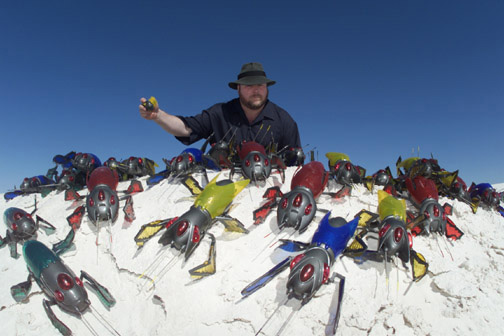
|
B.I.O. Mechanical Bugs Hit Stores
|

Dr. Mark W. Tilden, robotic physicist and creator of approximately 600 robots, takes his first toy invention, B.I.O. MECHANICAL BUGS, out for testing at the White Sands National Park, in Alamogordo, New Mexico. The bugs, made by the WowWee Division of Hasbro, Inc. (NYSE: HAS) are a new breed of artificial intelligence toy and the first to incorporate advanced "nervous networks" technology which enables them to respond to stimuli and mimic real insect behavior. Just like real bugs, they can identify friend or foe, avoid or climb over obstacles in their path and herd. (Jim Sulley/WirePix)
NEW YORK--Oct. 24, 2001--The much anticipated and highly touted B.I.O. MECHANICAL BUGS (Bio-mechanical Integrated Organism) from the WowWee Toy division of Hasbro Inc. (NYSE:HAS) have hit retail stores across the U.S.
First introduced at February's Toy Fair, B.I.O. MECHANICAL BUGS are the first toy line to incorporate advanced "nervous networks" technology. These robotic bugs can autonomously act by themselves, identify friend or foe and have the ability to avoid or climb over obstacles in their path. B.I.O. MECHANICAL BUGS are a new breed of artificial intelligence.
"We at KB Toys feel that B.I.O. MECHANICAL BUGS from WowWee Toys will be one of the hottest toys for 2001," says C.B. Alberts, vice president of KB Toys, "as it is one of the most unique combinations of science and toys that has ever been put together."
"The fact that they 'live' on their own in the house -- without support of a remote control -- should appeal to boys and girls of all ages, as well as adults," Alberts continued.
"B.I.O. MECHANICAL BUGS are a refreshing item for the toy industry and we look forward to great sales results during the fall," Alberts concluded.
"Nervous networks" technology was developed more than ten years ago and has been used by the U.S. government to create robotic creatures. 'Nervous net' is to these robotic bodies what a spine is to an organism -- it serves to connect functions together. So, rather than think about the task at hand, they react to the stimuli they confront.
It was during his tenure at Los Alamos, N.M., that robotic physicist Mark W. Tilden performed experiments and conducted extensive research using 'nervous net.' His research and findings were frequently featured in scientific journals and as part of televised documentaries about robotics.
A program broadcast on The Discovery Channel and featuring Dr. Tilden caught the attention of Richard and Peter Yanofsky, brothers and co-founders of WowWee Toys, now a division of Hasbro Inc., and toy inventors with a proven knack for developing successful toys with hi-tech applications. The question they posed to Dr. Tilden was, "can 'nervous net' technology work in a toy?"
The answer was a definitive yes and B.I.O. MECHANICAL BUGS is the first toy with a 'nervous net' application. "Nervous networks" takes your basic toy bug to the next level and enables B.I.O. MECHANICAL BUGS to mimic real insect behavior. They give kids the power to play with other bugs, other toys and unsuspecting humans.
"B.I.O. MECHANICAL BUGS are the quintessential toy of 2001," says Christopher Byrne, renowned toy expert known best as The Toy Guy(tm). "They combine the fascination that kids have with living things in the world around them with advanced robotics to create a sophisticated level of play that is rich with imaginative possibilities," he continued.
"B.I.O. MECHANICAL BUGS are the next frontier of robot play as they truly marry technology and the imagination," Byrne explained, "something that no other robotic toy has yet been able to accomplish quite so elegantly."
B.I.O. MECHANICAL BUGS react to outside stimuli -- a wall, another B.I.O. MECHANICAL Bug, even your foot -- and change or modify its behavior accordingly. Will it turn right or left, move forward, climb or retreat? B.I.O. MECHANICAL BUGS are always in motion, and just like real bugs, B.I.O. MECHANICAL BUGS are unpredictable.
"B.I.O. MECHANICAL BUGS are just like real bugs only without the tissue, with a battery as a heart and 'nervous network' technology acting as its brain," says Peter Yanofsky, president of WowWee Toys.
B.I.O. MECHANICAL BUGS FACTS
Left to their own devices, B.I.O. MECHANICAL BUGS first instinct is to survive -- at all cost. B.I.O. MECHANICAL BUGS adapt to surprising changes in situations and environment. However, if you don't want to let your B.I.O. MECHANICAL BUGS act autonomously, you can control their action with a wrist transmitter.
There are four different B.I.O. MECHANICAL BUGS species. Each one is a different color and is named for its defining characteristic -- PREDATOR (red), STOMPER (blue), DESTROYER (green) or ACCELERAIDER (yellow). Each comes with its own transmitter.
Color is key in this "21st century eco-system" because it defines the specific characteristics, strengths and weaknesses of each bug. For example, Destroyer has the ability to operate over rough terrain while Acceleraider moves quickest over smooth surfaces.
To keep their strength and power, B.I.O. MECHANICAL BUGS have to occasionally 'feed.' To do so, they return to their transmitter that acts as a feeding station, homing beacon and manual control.
Ages: 6 years and up
Approximate Retail Price: $39.99 USD
Availability: September 2001
Hasbro (NYSE:HAS) is a worldwide leader in children's and family leisure time entertainment products and services, including the design, manufacture and marketing of games and toys ranging from traditional to high-tech. Both internationally and in the U.S., its PLAYSKOOL, TONKA, MILTON BRADLEY, PARKER BROTHERS, TIGER and WIZARDS OF THE COAST brands and products provide the highest quality and most recognizable play experiences in the world.
Photo by Jim Sulley/Wirepix. Used with Permission.
  
|









